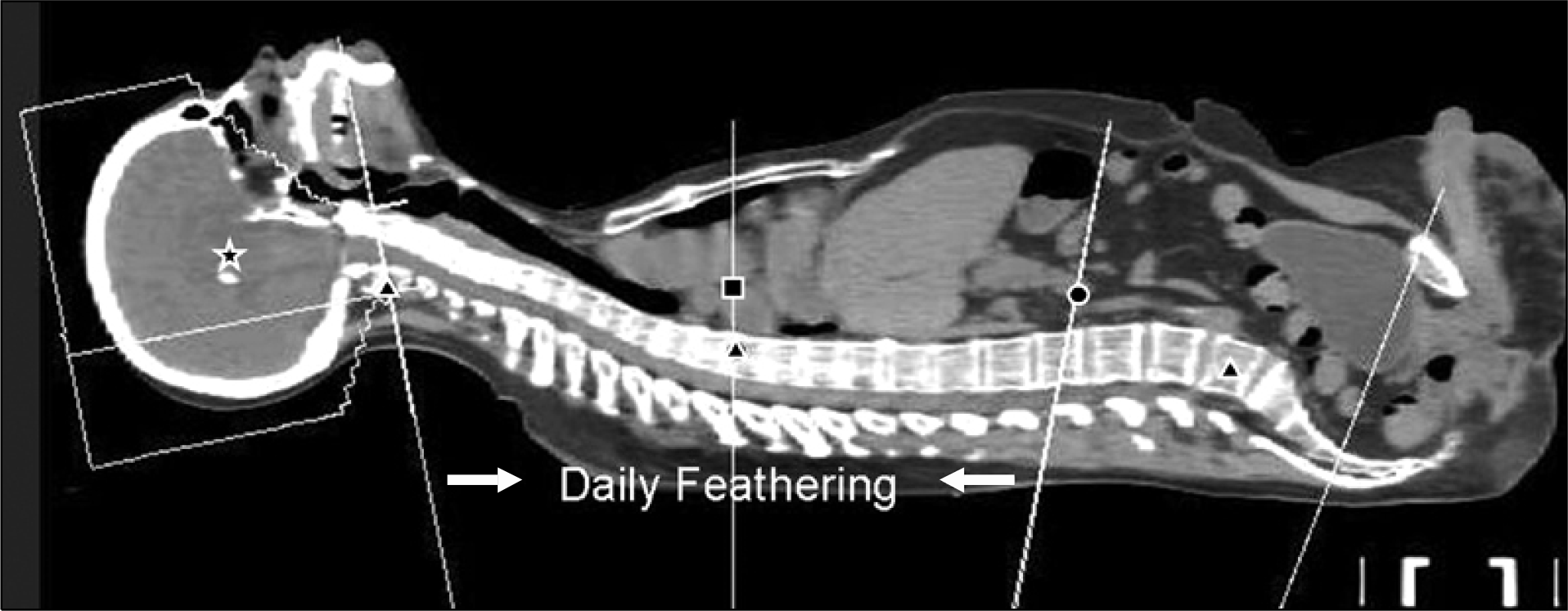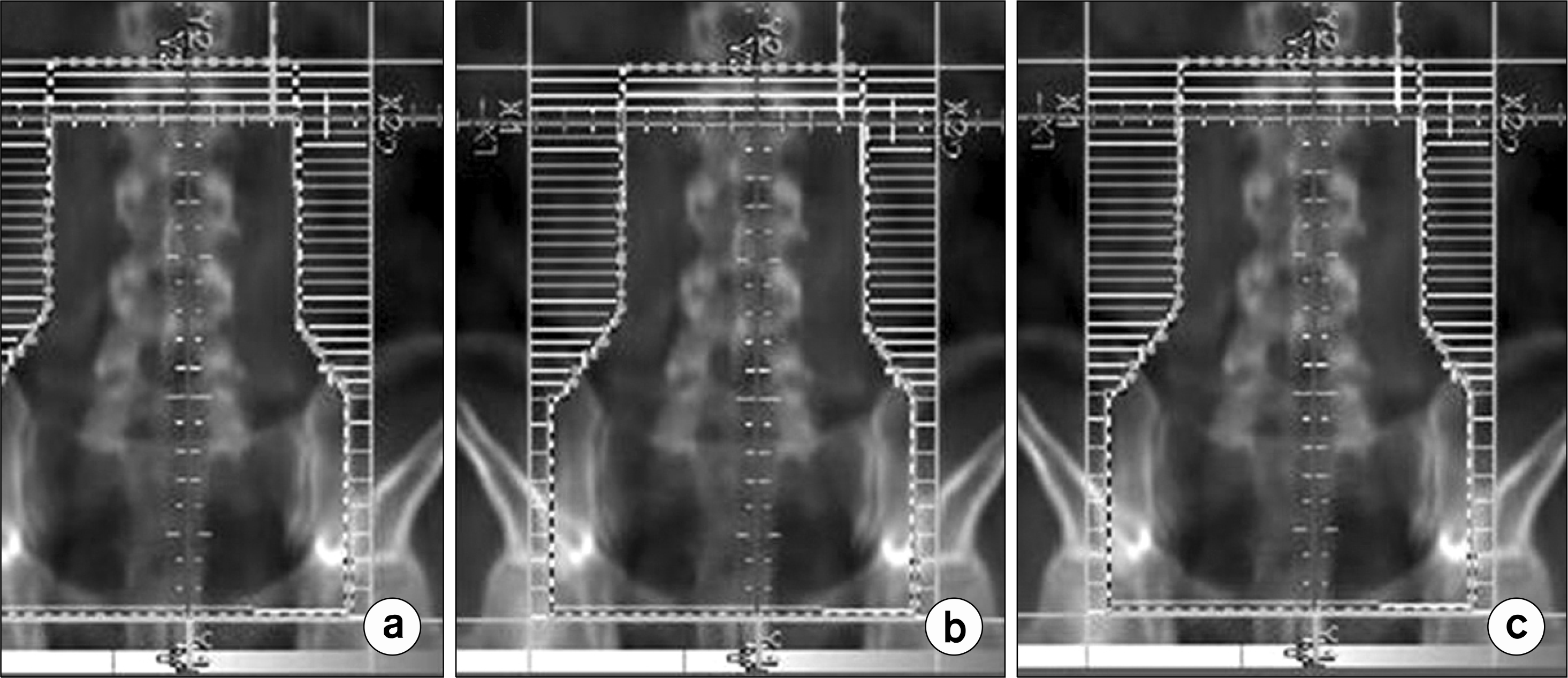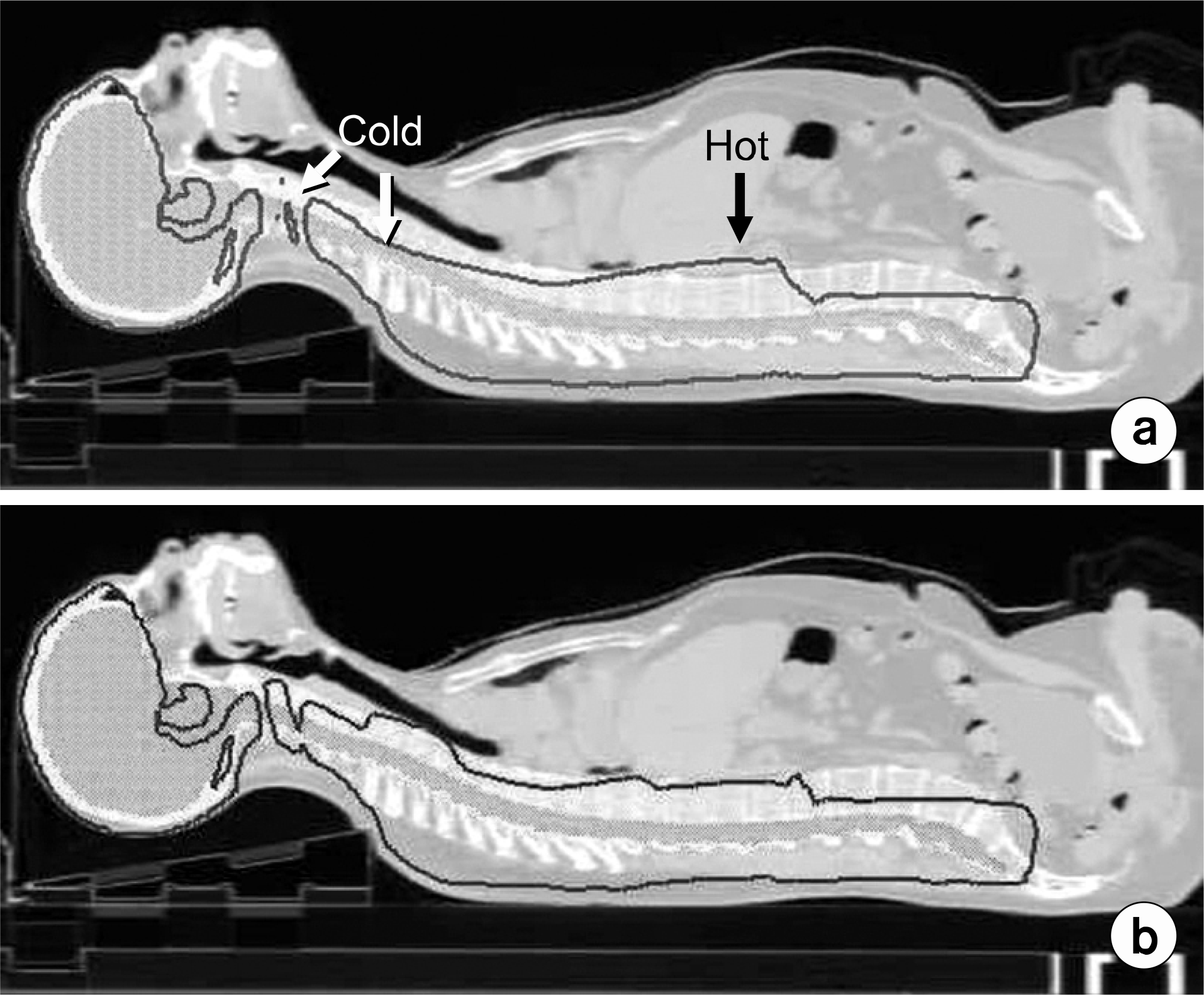Abstract
Our purpose is to present a novel technique for delivering craniospinal irradiation in the supine position using a perfect match, field-in-field (FIF) intrafractional feathering, and simple forward-optimization technique. To achieve this purpose, computed tomography simulation was performed with patients in the supine position. Half-beam, blocked, opposed, lateral, cranial fields with a collimator rotation were matched to the divergence of the superior border of an upper-spinal field. Fixed field parameters were used, and the isocenter of the upper-spinal field was placed at the same source-to-axis distance (SAD), 20 cm inferior to the cranial isocenter. For a lower-spinal field, the isocenter was placed 40 cm inferior to the cranial isocenter at a constant SAD. Both gantry and couch rotations for the lower-spinal field were used to achieve perfect divergence match with the inferior border of the upper-spinal field. A FIF technique was used to feather the craniospinal and spinal-spinal junction daily by varying the match line over 2 cm. The dose throughout the target volume was modulated using the FIF simple forward optimization technique to obtain homogenous coverage. Daily, image-guided therapy was used to assure and verify the setup. This supine-position, perfect match craniospinal irradiation technique with FIF intrafractional feathering and dose modulation provides a simple and safe way to deliver treatment while minimizing dose inhomogeneity.
Go to : 
REFERENCES
1. Parker WA, Freeman CR. A simple technique for craniospinal radiotherapy in the supine position. Radiother Oncol. 78(2):217–222. 2006; Epub 2005 Dec 5.

2. Munshi A, Jalali R. A simple technique of supine craniospinal irradiation. Med Dosim. 33(1):1–5. 2008.

3. Hawkins RB. A simple method of radiation treatment of craniospinal fields with patient supine. Int J Radiat Oncol Biol Phys. 49(1):261–264. 2001.

4. South M, Chiu JK, Teh BS, Bloch C, Schroeder TM, Paulino AC. Supine craniospinal irradiation using intrafractional junction shifts and field-in-field dose shaping: early experience at Methodist Hospital. Int J Radiat Oncol Biol Phys. 71(2):477–483. 2008; ). Epub 2007 Dec 31.

5. Yom SS, Frija EK, Mahajan A, et al. Field-in-field technique with intrafractionally modulated junction shifts for craniospinal irradiation. Int J Radiat Oncol Biol Phys. 69(4):1193–1198. 2007.

6. Pai Panandiker A, Ning H, Likhacheva A, et al. Craniospinal irradiation with spinal IMRT to improve target homogeneity. Int J Radiat Oncol Biol Phys. 68(5):1402–1409. 2007; Epub 2007 Apr 30.
7. Parker W, Filion E, Roberge D, Freeman CR. Intensitymodulated radiotherapy for craniospinal irradiation: target volume considerations, dose constraints, and competing risks. Int J Radiat Oncol Biol Phys. 69(1):251–257. 2007.

8. Kusters JM, Louwe RJ, van Kollenburg PG, et al. Optimal normal tissue sparing in craniospinal axis irradiation using IMRT with daily intrafractionally modulated junction(s). Int J Radiat Oncol Biol Phys. 81(5):1405–1414. 2011.

9. Chang EL, Wong PF, Forster KM, Petru MD, Kowalski AV, Maor MH. Verification techniques and dose distribution for computed tomographic planned supine craniospinal radiation therapy. Med Dosim. 28(2):127–131. 2003.

10. Rades D, Baumann R, Bremer M, Leuwer M, Karstens JH. Application of a new verification technique allowing craniospinal irradiation in supine position. Radiother Oncol. 58(2):215–217. 2001.

Go to : 
 | Fig. 1.Sagittal representation of the cranial field, upper-spinal field, and lower-spinal field, with each isocenter at a constant source-to-axis distance (illustrated by the star, square, and circle, respectively). Calculation points for each field are indicated by triangles. |
 | Fig. 2.Couch and gantry rotation for the spinal fields. (a) Upper spine (couch, 0o; gantry, 180o). (b) Lower spine (couch, 270o; gantry, 191o). |
 | Fig. 3.(a) Cranial treatment field. (b) and (c), Illustration of the field-in-field technique used to feather the match of the craniospinal junction. |
 | Fig. 4.(a) Upper-spinal treatment field. (b) and (c), Illustration of the field-in-field technique used to feather the match of the craniospinal junction superiorly and the spinal-spinal junction inferiorly. (d) and (e) Illustration of the field- infield technique used to modulate the dose throughout the upper-spinal field. |




 PDF
PDF ePub
ePub Citation
Citation Print
Print




 XML Download
XML Download